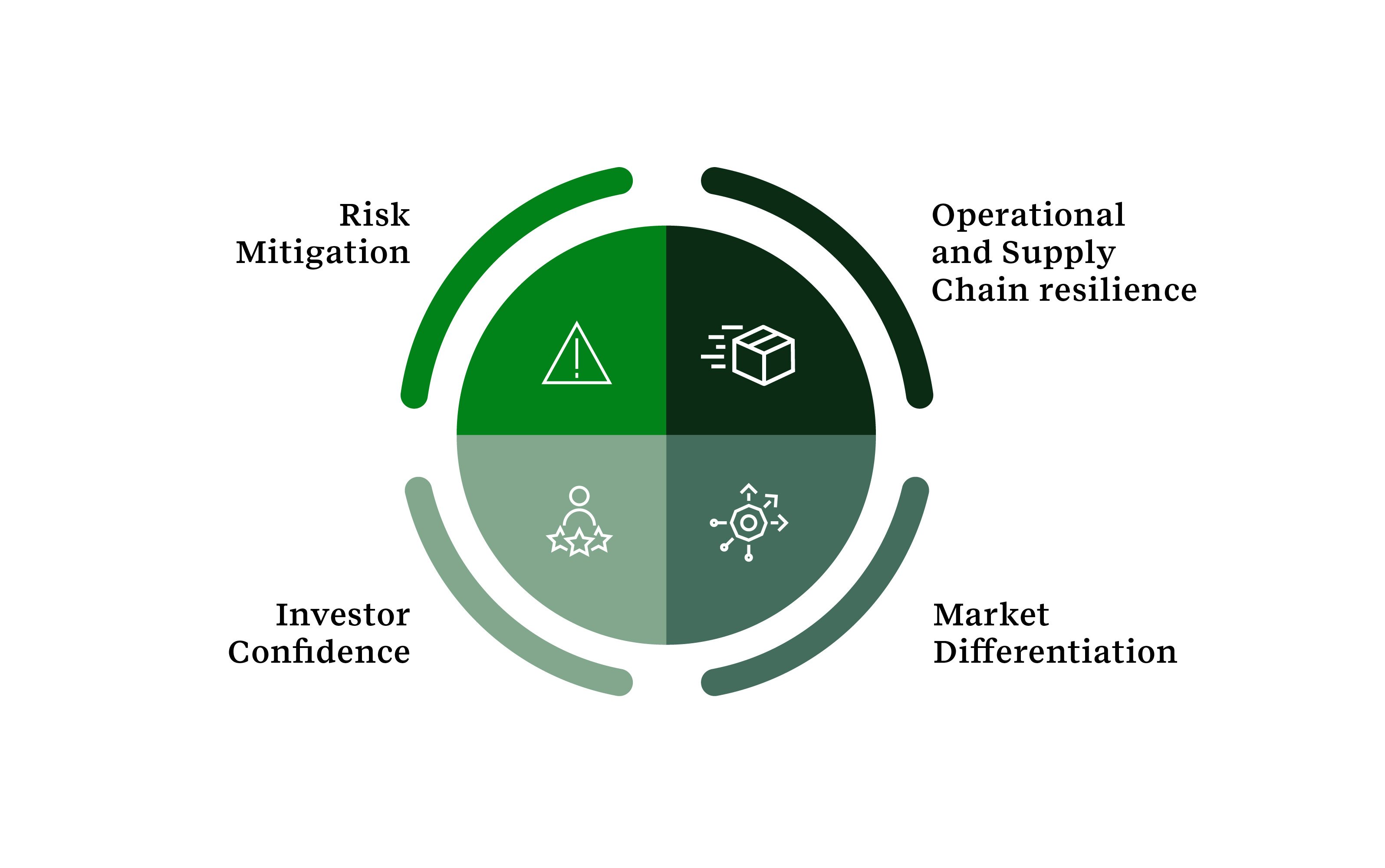Key takeaways
- Climate-related disclosure is fast becoming a regulatory necessity: With the introduction of California’s SB 261 and the emergence of similar regulations worldwide, companies are increasingly required to disclose their climate-related financial risks.
- Initial risk assessments face limitations: While many companies have completed an initial climate-related financial risk assessment, some are finding limitations in the outputs, which prevent them from leveraging the assessment for strategic action.
- Climate Risk Assessments (CRAs) are central to compliance and strategic value creation: CRAs can help companies identify climate-related financial risks for disclosure and unlock strategic value by determining cost-saving opportunities, strengthening supply chain resilience, and uncovering growth in emerging low-carbon markets
- Turning insights into action is key to resilience and competitiveness: Companies that go beyond compliance by integrating CRA findings into their strategy, governance, and operations will be better positioned to thrive in a low-carbon economy.
Climate change is an inescapable economic reality. In 2024, natural disasters caused $320 billion in global economic losses, up from $268 billion in 2023, as severe weather events became more frequent and intense. By 2050, companies in the S&P Global 1200 are projected to face as much as $1.2 trillion in physical climate-related financial risks annually. In parallel, the transition to a lower-carbon economy is reshaping the financial landscape. In 2024, carbon-pricing mechanisms worldwide generated about $103 billion in fees signaling the growing costs faced by high-emitting businesses.
Climate change impacts businesses both indirectly, for example, through supply-chain disruptions and rising input costs and directly via effects like physical damage to facilities. At the same time, the shift to a low-carbon economy is opening new markets, reshaping customer expectations, and rewarding companies that can adapt quickly. A well-executed Climate Risk Assessment (CRA) helps businesses understand these combined pressures and uncover opportunities to cut costs, strengthen resilience, and capture growth in emerging low-carbon markets.
The disclosure angle: Regulations are prompting Climate Risk Assessments
As corporate exposure to climate change grows, regulators worldwide are expanding disclosure requirements to improve transparency and help stakeholders understand financial and other risks that could disrupt markets if left unmanaged. Jurisdictions from the European Union and United Kingdom to Australia, China, and Mexico already have such rules in place, with more on the way.
California’s SB 261 regulation – the Climate-Related Financial Risk Act – makes the state a leader among sub-national jurisdictions requiring climate-related financial risk disclosure. Beginning January 1, 2026, companies with more than $500 million in global annual revenue that do business in California must publish biennial reports disclosing their climate-related risks, mitigation and adaptation strategies, and governance processes. SB 261 is also being used as model for regulation being developed by other U.S. states, including Illinois and New Jersey.
|
To align with SB 261’s reporting requirements, companies must first conduct a Climate Risk Assessment (CRA).
Climate Risk Assessments and why they matter
CRAs systematically identify and evaluate a company’s exposure to both physical hazards (like extreme weather and water stress) and transition risks (such as shifting regulations, carbon pricing, technology disruption, and changing customer preferences). The insights reveal how climate dynamics can affect company operations, supply chains, cost structures, and market positioning.
While every assessment is tailored to the individual company, basic CRAs include:
- Identifying current and future physical and transition risks: This includes risks ranging from heatwaves, floods, and water stress to energy price volatility, carbon-cost exposure, evolving regulations, technology shifts, and changing demand for low-carbon products.
- Mapping business exposure: Determining which assets, functions, supply chains, and revenue streams are most at risk under different climate and policy scenarios.
- Assessing susceptibility and materiality: Evaluating how vulnerable these business exposures are to financial, operational, and market disruptions.
- Estimating potential business impacts: Using a combination of scenario data and company-specific inputs, organizations estimate or calculate the potential financial effects—such as changes to revenue, operating costs, and capital-expenditure needs—of climate-related financial risks.
- Assessing existing mitigation measures and risk-management processes: Assessment should cover areas such as infrastructure investments, supply-chain controls, insurance, and operational protocols, to understand how well they address identified risks.
- Identifying gaps and priorities for action: Highlighting areas where current risk mitigation measures are insufficient and companies must pursue remedial actions.
Insights gleaned from CRAs can form the foundation of corporate climate risk management plans and/or climate action/transition plans, detailing targeted mitigation and adaptation strategies to close gaps and embed climate resilience into core business decisions.
Climate risk assessment as a pathway to business benefit
With climate impacts rising and regulations like SB 261 expanding disclosure requirements, companies are increasingly conducting CRAs. However, CRA insights often remain siloed within sustainability teams, limiting value beyond compliance.
To ensure business benefit, companies should ensure their CRAs equip business leaders with the data and foresight they need to influence capital allocation, guide product and market strategy, and strengthen competitive positioning. Strategically approached, CRAs highlight where companies can protect value, capture growth opportunities, and future-proof their business models in a shifting policy and market landscape.

The core value drivers of CRAs—risk mitigation, operational and supply-chain resilience, investor confidence, and market differentiation—represent the broad business outcomes that a robust assessment aims to deliver. However, achieving these outcomes and unlocking business value requires more than producing a report. Companies must translate CRA insights into decisions and processes that affect investment priorities, governance processes, workforce capabilities, and customer offerings.
The following table highlights a set of cross-cutting actions we have seen companies across industries apply to turn CRA insights into concrete steps that deliver measurable benefits. These actions demonstrate how businesses can move from simply understanding their risks to embedding climate considerations into everyday decision-making and long-term strategy.
Seizing opportunity through climate-driven transformation
As climate risks and transition pressures intensify, companies that act now can protect their core business and gain a competitive edge. A CRA is the starting point, however, its true value lies not in conducting the assessment but in how its resultant insights guide investment, product strategy, supply chains, and governance.
To turn insights into actions, consider these questions as you plan your organization’s next steps:
- Which CRA insights should inform our next major investment or divestment decision?
- What revenue-generating low-carbon products or markets may be available to us if we move early?
- How can we embed climate considerations into our enterprise risk management processes to ensure they are part of everyday decision-making?
- What capability or data gaps do we need to address to effectively act on these insights?
Companies that begin addressing these questions now will not only improve their short-term resilience - they will also be better positioned to thrive in a low-carbon future.



